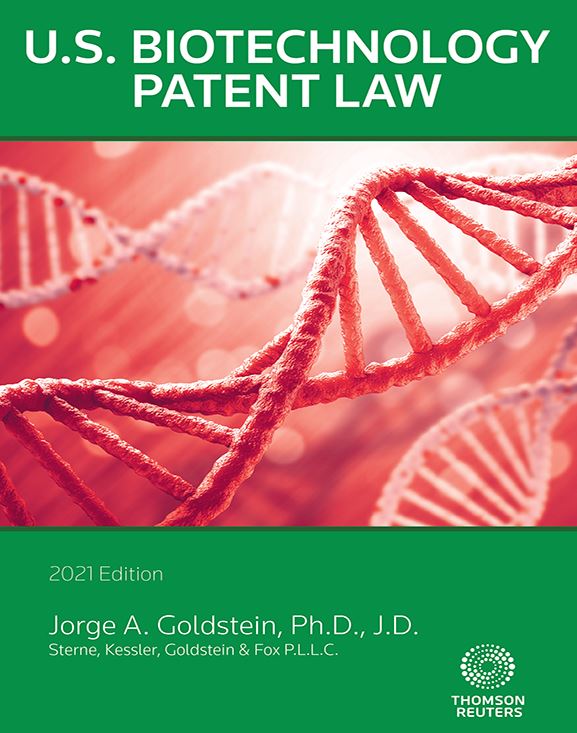U.S. Biotechnology Patent Law, 2021 ed., authored by firm director Jorge A. Goldstein, Ph.D., is an update to the fifth edition.
U.S. Biotechnology Patent Law is a highly readable and well-organized desktop companion for practicing attorneys, and patent agents, seeking effortless entry into U.S. caselaw dealing with patents in modern biotechnology. Using the book’s descriptive subtitles or its double-entry tables, experienced or novice prosecutors, litigators, inside counsel or academicians can readily access any sub-area of the law, understand the legal background, and then find clear descriptions of the most important cases. The book’s focus is on biotechnology cases decided by the Court of Appeals for the Federal Circuit, its predecessor, the Court of Customs and Patent Appeals, the U.S. Supreme Court, and – when relevant – the U.S. Patent & Trademark Office Appeal Boards.
U.S. Biotechnology Patent Law features a contemporary format and feel, in both print and electronic formats. Each important biotech case is prominently highlighted and includes, in order:
- A summary and relevance of the holding;
- Separate patent claims (Since the holdings in patent law can only be understood in reference to the claims – Are they methods? Products? What are the exact words and limitations? – the author has separated the involved claims for immediate access.);
- Technology drawings or other facts needed for a clearer understanding; and
- Verbatim citations and quotes from the tribunal.
Throughout the publication, there are comments contained in shaded boxes, allowing the reader to easily distinguish the discussions in the cases from the opinions of the author. These comments include trends in the caselaw, critiques of outlier cases, and attempts to provide unifying themes to the historical and thematic development of the caselaw. Also included are diagrams that, at a glance, provide understanding of a body of caselaw, such as, for example, the development of a drug from early research to a time after approval by the FDA, or a summary of enablement and written description.
And, featured at the end of the book are a series of appendices in the form of double-entry tables that provide additional access to the caselaw. For example, if readers look for cases on antibodies across all statutes of the patent law, they find them in the appropriate row; if they want cases dealing with enablement across all scientific areas of biotechnology, they find them in the appropriate column; and if they want only enablement cases on antibodies, they find them in the cell at the intersection.
Highlights of This New Edition
Among the numerous revisions in the 2021 Edition of U.S. Biotechnology Patent Law are the following:
• Chapter 3. Eligibility of methods of correlating followed by treatment. Update includes discussion of In re Board of Trustees of the Leland Stanford Junior University, where the claims were deemed not eligible, as being nothing more than computer algorithms and abstract mental ideas followed only by a generalized post solution activity.
• Chapter 5. Enabling a genus claim to DNA sequences and methods of sequencing. Update includes discussion of Pacific Biosciences of California, Inc. v. Oxford Nanopore. The case highlights the importance of enabling the full scope of a challenged claim and not just a portion.
• Chapter 6. Comment: Similarities between the analysis of enablement and written description. The update includes a discussion of Amgen v. Sanofi (2021), where the court extended an analogy it had first used in AbbVie Deutschland in an analysis of written description, to the enablement context: Describing or enabling only one corner of a field does not enable or describe the entire field.
• Chapter 9. Novelty of a method of treatment using a product made recombinantly. The update incudes a discussion of Biogen MA Inc. v. EMD Serono, Inc., et al., where, absent proof that the recombinant production connoted a novel product, the claim was found not novel over the same treatment using the native – not the recombinant – human polypeptide.

Receive insights from the most respected practitioners of IP law, straight to your inbox.
Subscribe for Updates
